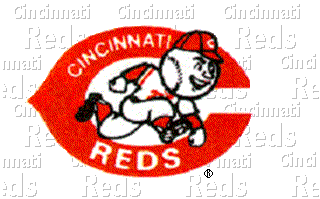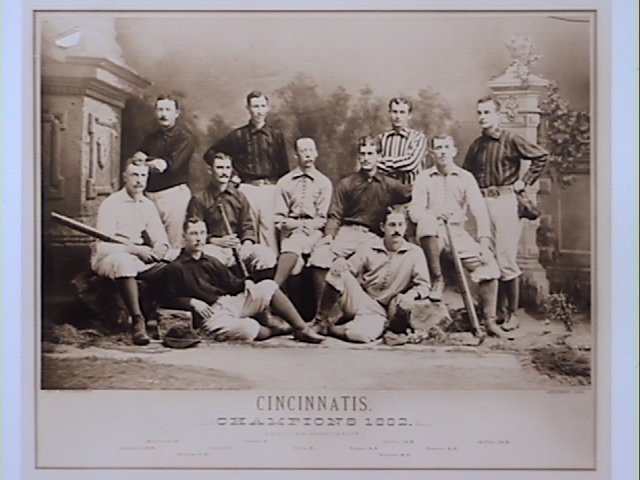 CINCINNATI REDS
CINCINNATI REDS
 CINCINNATI REDS
CINCINNATI REDS

Here is a picture of the 1882 Cincinnati Red Stockings

The history of professional baseball begins in Cincinnati. Cincinnati
is the home of the very first professional baseball team, and a charter member of the
National League. During the 1970s, Cincinnati was home to the famed "Big Red
Machine," one of the most dominant teams in the history of sports.
![]()
The first professional team of all time was the 1869 Cincinnati Red Stockings. No other
club had ever composed its entire roster of paid ballplayers before (i.e., no amateurs at
all), and they were sensationally successful. Led by George & Harry Wright, the Red
Stockings played their first practice game April 17, 1869 (a 24-15 win), their first
official game June 1, 1869 (a 48-14 rout over the Mansfield Independents), and eventually
reeled off 130 consecutive games without a loss before falling to the Brooklyn Atlantics
in June of 1870.
![]()
In 1876, the National League was founded and the Red Stockings were charter members. The
Reds left the league from 1881-1889 (due largely to the fact that the league would not
permit the sale of beer in the ballpark), but returned in 1890, and have been in the NL
ever since.
![]()
The turn of the century saw one of the most colorful men ever associated with the Reds
take control of the club. August "Garry" Herrmann was team president from 1902
until 1927, when he was forced to retire due to declining health. Herrmann was at the helm
on April 11, 1912 when Redland Field (later known as Crosley Field) was officially
dedicated. The beloved old ballpark would serve as the Reds' home until 1970, hosting a
total of 4,543 games.
![]()
A host of famous players paraded through the Herrmann regime. Frank "Noodles"
Hahn was a durable, standout pitcher, and OF Cy Seymour won the Reds' first batting
championship when he hit .377 in 1905, a mark which still stands in the Cincinnati record
book.
![]()
Later came Edd Roush, an all-time great center fielder, and Heinie Groh, the famous third
baseman who used a bottle-shaped bat. They formed the nucleus of Cincinnati's first
pennant winner in 1919, and went on to beat the Chicago White Sox in the World Series.
![]()
During the roaring '20s, Reds' players such as Eppa Rixey (who still holds the club record
with 179 pitching victories) and Bubbles Hargrave (the first catcher ever to win a batting
title) kept Cincinnati in the running. But after Garry Herrmann resigned control of the
team in the late 1920s, the Depression crippled the team's owners and limited the Reds'
success on the field as well.
![]()
Powel Crosley Jr., the famous radio tycoon, purchased the team in 1934. He did so mostly
for civic purposes, as it was strongly rumored that the Cincinnati franchise might be
moved, and Crosley felt that the city needed a major league baseball team.
![]()
One of the people who helped convince Crosley was Larry MacPhail, the Reds' colorful
general manager. MacPhail, one of the early promoters in baseball, opened up a new era for
the sport when the Reds became the first big-league team ever to play at night. Lights
were installed at the newly-renamed Crosley Field, and on May 24, 1935, the Reds and
Phillies squared off in the first night game. Even with a very limited number of evening
games on the schedule, Cincinnati crowds soared from their previous levels.
![]()
Two years later, a new chapter opened in Cincinnati as Warren Giles was named General
Manager. Although the Reds finished last in Giles' first season, the team began to move up
in 1938 -- they jumped to fourth place, and pitcher Johnny Vander Meer fired no-hitters in
consecutive starts. By 1939, the club had become the league's best, winning back-to-back
pennants in 1939 and 1940. Cincinnati captured the World Series in 1940, taking an
exciting, seven-game series from the Detroit Tigers (helped by a remarkable performance
from their 40 year old "coach-turned-catcher," Jimmy Wilson).
![]()
Some of the greatest names in Reds' history were on those teams. Paul Derringer, Bucky
Walters and Johnny Vander Meer were talented pitchers. 1B Frank McCormick, catcher Ernie
Lombardi and Walters all won Most Valuable Player awards. The manager of the squad was
Hall of Famer Bill McKechnie.
![]()
World War II and age caught up with the Reds during the 1940s, and the club began
rebuilding in the late '40s and early '50s. Ewell "The Whip" Blackwell became
the first pitcher to pitch in six straight All-Star games, and muscular 1B Ted Kluszewski
was signed off the Indiana University campus.
![]()
Warren Giles left the Reds in 1951 when he became president of the National League. His
successor, Gabe Paul, assembled a powerful hitting club in the mid-'50s. Cincinnati nearly
won the pennant in 1956, losing by just two games to Brooklyn, but the fans fell in love
with this team. The Reds tied the NL record for most team home runs (221), and hit the
million mark in attendance for the first time. Skipper Birdie Tebbetts was crowned Manager
of the Year.
![]()
Manager Fred Hutchinson took command of the Reds in 1959, and in '61 they startled many
"experts" by winning the NL pennant. OF Frank Robinson, who had been Rookie of
the Year in 1956, was the league's Most Valuable Player, and OF Vada Pinson nearly won the
batting title. Under the popular Hutchinson, who died of cancer in 1964, the Reds averaged
over 90 wins per season from 1961-64.
![]()
Rumors again spread in 1966 that the Reds would leave Cincinnati. They were silenced
though, when a group of businessmen, led by Francis L. Dale, purchased the Reds and
pledged allegiance to the city with a 40-year lease, thus assuring construction of a new
stadium. As the '70s opened, Bob Howsam was the General Manager, the brand new Riverfront
Stadium was about to open, Sparky Anderson had just been named team's manager ...and the
Reds were on
the threshold of the greatest decade in their history.
![]()